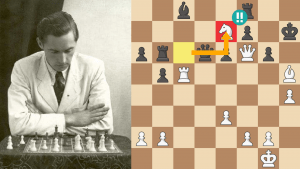
A Key Tactical Theme
IMPORTANT: [At the end of the puzzles, you should click MOVE LIST so you can see my instructive notes and variations. If you are having trouble solving a problem, just click SOLUTION, and then MOVE LIST. Even if you solve everything, DO click MOVE LIST or you might miss an important bit of prose.]
C. Peterson (2024) – C. Yarbrough (1545), [B64] Denver Chess Club, 2012
1.e4 c5 2.Nf3 d6 3.d4 cxd4 4.Nxd4 Nf6 5.Nc3 Nc6 6.Bg5 e6 7.f4 Be7 8.Qd2 0-0 9.0-0-0
9…Qb6
Rare. Black’s main moves are 9…Nxd4 and 9…h6 10.Bh4 e5, which both lead to theory-intensive lines.
10.Ndb5
10.Nf3 is white’s most popular reply.
10…Rd8 11.Na4
11.Bxf6 is a critical choice:
11…Qa5
11…Qa6!?
12.Qxa5 Nxa5 13.e5?!
This move risks a weak e5-pawn (that’s right – push your pawns too fast and they become fodder for the enemy pieces) for the promise of material gains, but this win of enemy wood turns out to be an illusion. In a way White’s 13.e5 is going “all in” (to borrow the poker term), but bluffing doesn’t work too well in chess, and if you go all in you better make sure you have the cards!
Instead of 13.e5, White could have tried 13.Bxf6 gxf6:
13…dxe5 14.Rxd8+
14.fxe5 Rxd1+ 15.Kxd1 Nd5 is less than nothing for White.
14…Bxd8 15.fxe5 h6!
This refutes white’s try at material gain. It's a common device in such situations. See the examples under this note for more on this theme.
16.Be3
Of course, 16.Bh4 is the critical move, when Black shows the final bit of his saving idea:
16…a6?!
Black gets fancy when the simple 16...Ng4! would have been the way to go:
17.Nd6
White also fails to get anything after 17.exf6:
17…Nd5
Also possible was 17…Nd7!? 18.Be2 Nc6, targeting e5.
18.Bf2 Bg5+?!
The check wasn’t going away, so this move wasn’t necessary or even desirable (since the Bishop on d8 makes sure nothing will infiltrate on b6). Far more interesting was 18…b5:
19.Kb1 Bd7 20.Nc5 Bc6 21.c4
21…Ne3 22.b4 b6 23.Nxa6?
The higher rated player cracks! He should have played 23.h4!:
23…Nxf1?
Missing his chance! The straightforward 23…Rxa6! should have been played:
24.Rxf1 Nb7?
A big step towards the abyss. Black could have retained the better game by chopping on c4:
25.Nc7?
And White returns the favor. Instead, 25.b5 was very strong:
25…Bxg2??
Black steps off the cliff. Now he’s dead lost. 25...Ra4! was the way to go, when we get some very interesting positions:
26.Nxa8 Bxf1 27.Nxb7?
27.Nxb6! (clearing the way for the a-, b-, and c-pawns), followed by the comment, “Release the hounds!” was crushing.
27...Bg2 28.Nd6?
28.Nxb6 was still correct.
28...Bxa8 29.Bxb6 Bf4 30.Bd4 Bxh2?
Taking this pawn gives White a free tempo to roll his pawns forward. Instead, 30...f6 creates some counterplay, and would at the very least give White a chance to go wrong:
31.c5
31.b5 was stronger.
31…Bc6??
31...f6 still put up a fight!
32.b5 Bd5 33.c6 f6 34.c7, 1-0. A great, extremely complicated, battle! Mr. Yarbrough, who was much lower rated than his opponent, did himself proud.
LESSONS FROM THIS GAME
* The anti-pin theme that we explored on move 15 should be easy to master. Take the time to do so!
* Pawns can’t move backwards, so don’t push your pawns too fast or they might become fodder for the enemy pieces!
* If you don’t have time to study opening theory in detail, pick openings that demand understanding over endless memorization. The Sicilian usually demands both!
HOW TO PRESENT A GAME FOR CONSIDERATION
If you want me to look over your game, send it to askjeremy@chess.com
I need your name (real or chess.com handle), your OPPONENT’S name (real or chess.com handle), both players’ ratings, where the game was played, and date. If you don’t give me this information, I won’t use your game! BTW: I’ve noticed that many people are reluctant to give me their opponent’s name. This is very strange! Showing the names of both players is the way chess games are presented in databases, books, magazines… everywhere! Permission from the opponent isn’t necessary. If permission was necessary, everyone who ever lost a game wouldn’t allow their name to be on it!






